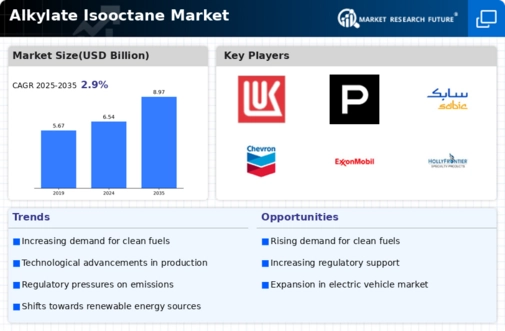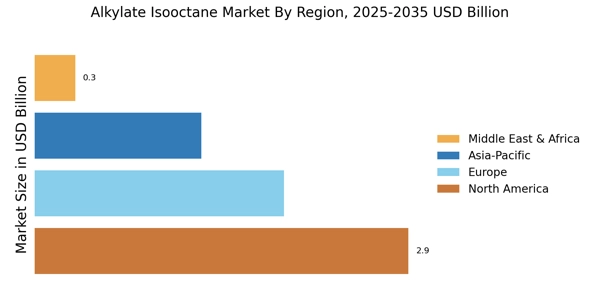Regulatory Influence
The Alkylate Isooctane Market is significantly shaped by regulatory frameworks that govern fuel quality and emissions standards. Governments worldwide are increasingly implementing stringent regulations aimed at reducing environmental impact and promoting cleaner fuels. For instance, regulations such as the Tier 3 standards in the United States mandate lower sulfur content in fuels, which enhances the demand for high-octane, low-emission alternatives like alkylate isooctane. This regulatory push not only drives the market but also encourages refiners to invest in cleaner production technologies. As a result, the Alkylate Isooctane Market is likely to experience growth as manufacturers adapt to these evolving regulations, ensuring compliance while meeting consumer demand for cleaner fuels.
Consumer Preference Shift
The Alkylate Isooctane Market is witnessing a notable shift in consumer preferences towards cleaner and more efficient fuel options. As awareness of environmental issues grows, consumers are increasingly seeking fuels that offer lower emissions and better performance. Alkylate isooctane, known for its high octane rating and low volatility, is becoming a preferred choice among environmentally conscious consumers and automotive manufacturers. This shift is reflected in the rising demand for high-performance fuels in the automotive sector, where alkylate isooctane is favored for its ability to enhance engine efficiency and reduce harmful emissions. Consequently, the Alkylate Isooctane Market is likely to expand as manufacturers respond to this changing consumer landscape.
Technological Advancements
Technological advancements play a pivotal role in the Alkylate Isooctane Market, particularly in refining processes and production efficiency. Innovations in catalytic processes and separation technologies have enabled the production of alkylate isooctane with higher purity and lower environmental impact. For example, advancements in isomerization and alkylation processes have led to increased yields and reduced energy consumption. These improvements not only enhance the economic viability of producing alkylate isooctane but also align with the industry's shift towards sustainability. As technology continues to evolve, the Alkylate Isooctane Market is expected to benefit from enhanced production capabilities, potentially leading to lower prices and increased market penetration.
Economic Growth and Urbanization
Economic growth and urbanization are driving factors in the Alkylate Isooctane Market, particularly in emerging economies. As urban populations expand, the demand for transportation fuels increases, leading to a higher consumption of gasoline and its derivatives. Alkylate isooctane, with its superior properties, is well-positioned to meet this growing demand. The rise in disposable incomes also contributes to increased vehicle ownership, further propelling the need for high-quality fuels. In regions experiencing rapid industrialization, the Alkylate Isooctane Market is expected to flourish as infrastructure development and transportation networks expand, creating a favorable environment for fuel consumption.
Environmental Concerns and Sustainability
Environmental concerns and the push for sustainability are critical drivers in the Alkylate Isooctane Market. As climate change becomes a pressing global issue, there is a concerted effort to transition towards cleaner energy sources. Alkylate isooctane, recognized for its low emissions and high efficiency, aligns with these sustainability goals. The market is likely to benefit from initiatives aimed at reducing carbon footprints and promoting renewable energy sources. Additionally, the increasing adoption of stringent environmental regulations is compelling fuel producers to innovate and offer cleaner alternatives. This trend suggests that the Alkylate Isooctane Market will continue to grow as stakeholders prioritize sustainability in their operations.


















Leave a Comment